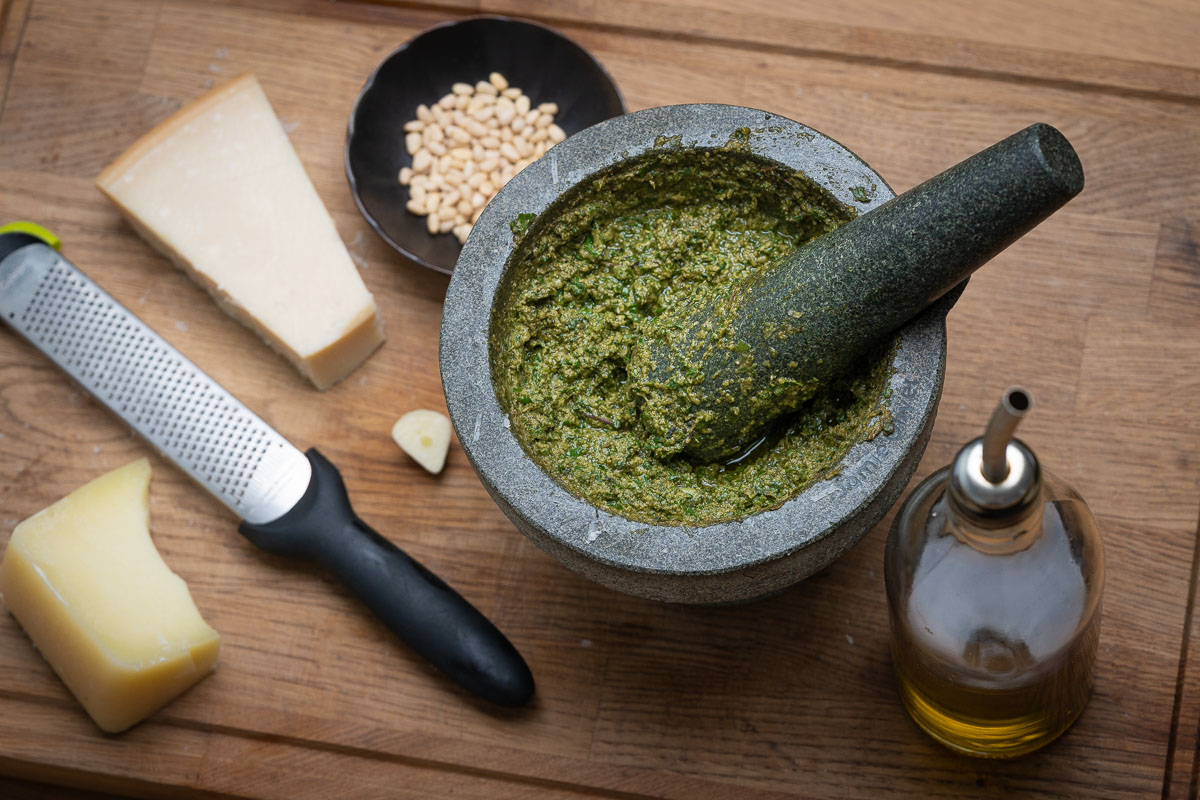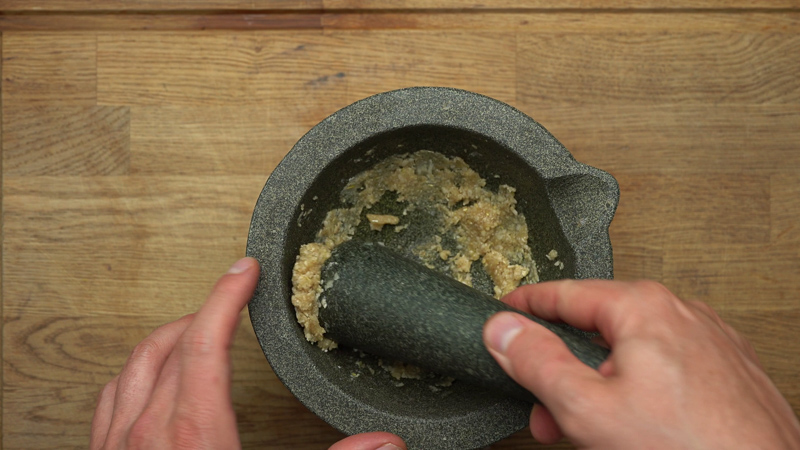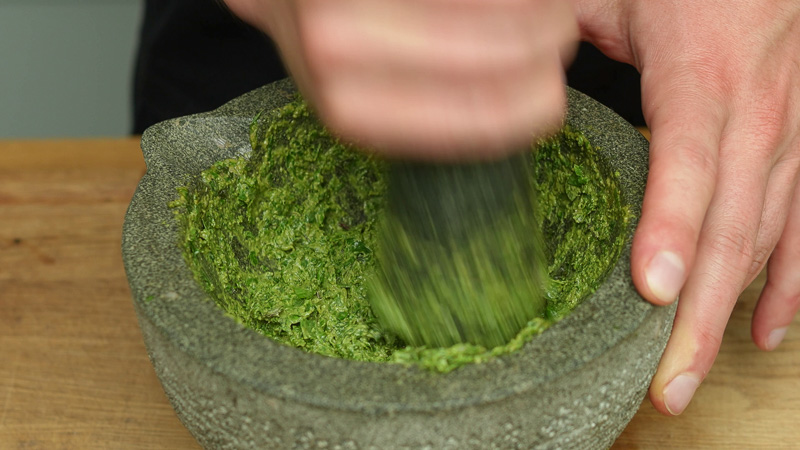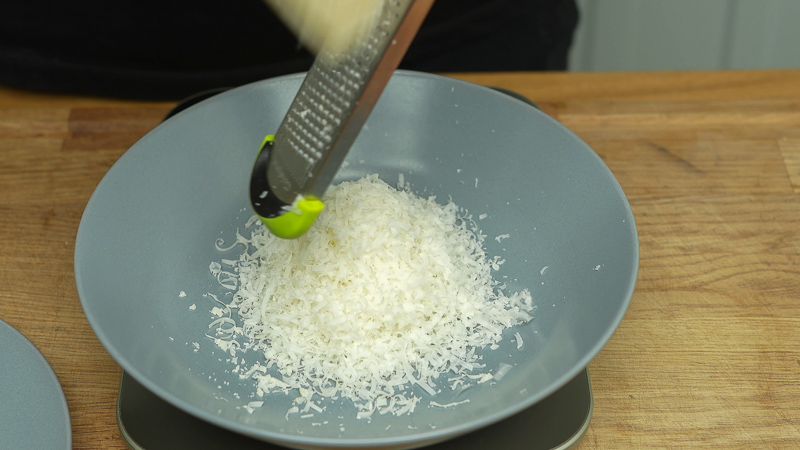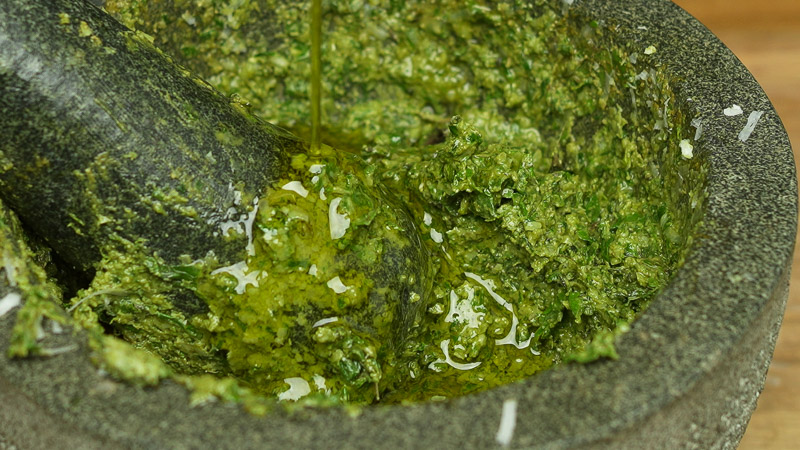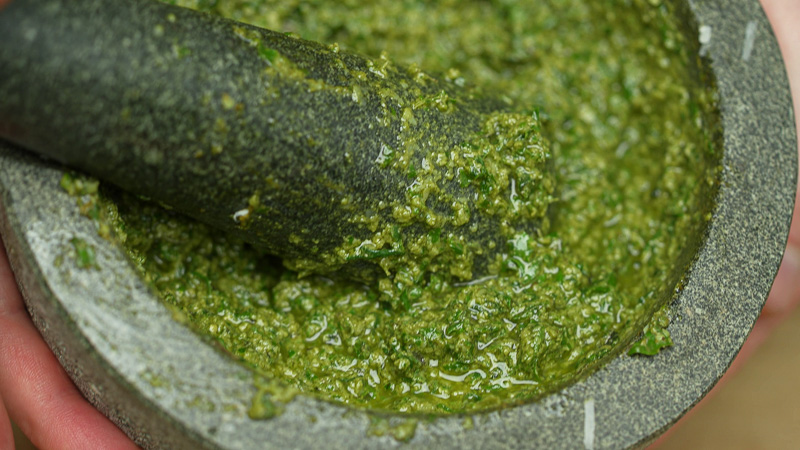There is hardly any sauce that comes close in terms of fragrance and flavors of a homemade pesto alla genovese recipe. – the vibrant green sauce that captures the essence of Italian summers!
Did you know that this iconic Ligurian dish dates back to the 16th century? Today, I’m thrilled to share my traditional Pesto alla Genovese Recipe with you. You’ll learn the classic way and secrets of creating the most authentic and mouthwatering pesto alla genovese right in your own kitchen.
Pesto alla Genovese Recipe – Table of Contents
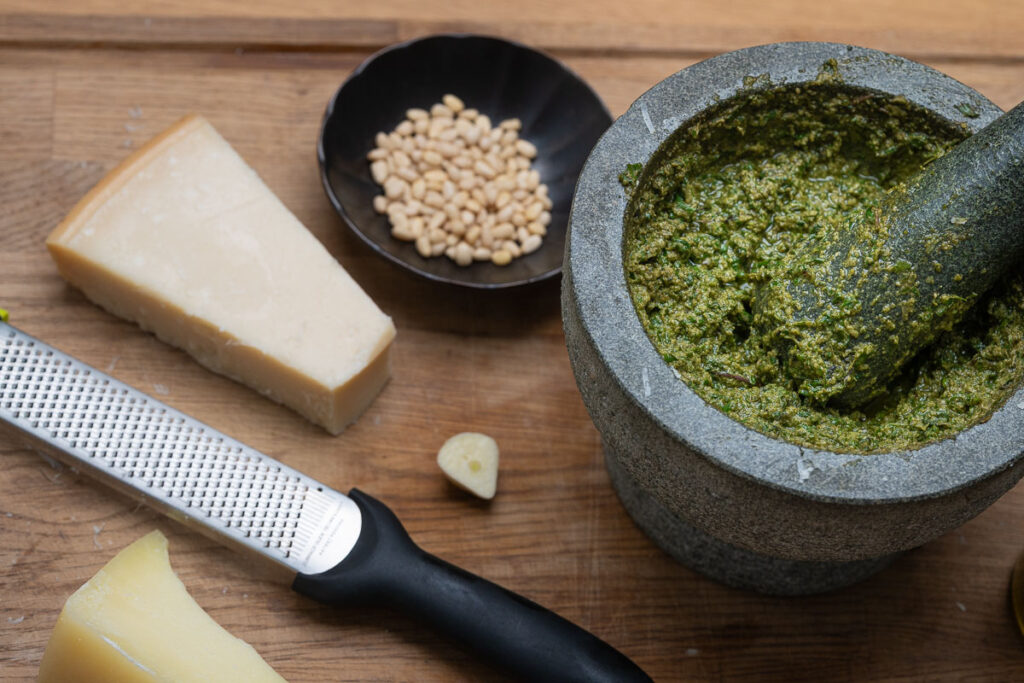
The History and Origins of Pesto alla Genovese
Let’s take a delicious journey through time and explore the roots of pesto alla Genovese. This iconic Italian sauce has a rich history that dates back centuries.
Did you know that pesto originated in Liguria, a beautiful coastal region in northwestern Italy? It’s true! The city of Genoa, in particular, is considered the birthplace of this aromatic green sauce.
Over time, the recipe has evolved, though its essence remains the same. It’s fascinating how a simple combination of ingredients can become such a cultural touchstone, isn’t it? Pesto alla Genovese has become an integral part of Italian cuisine, representing the flavors and traditions of Liguria.
Essential Ingredients for my Pesto alla Genovese Recipe
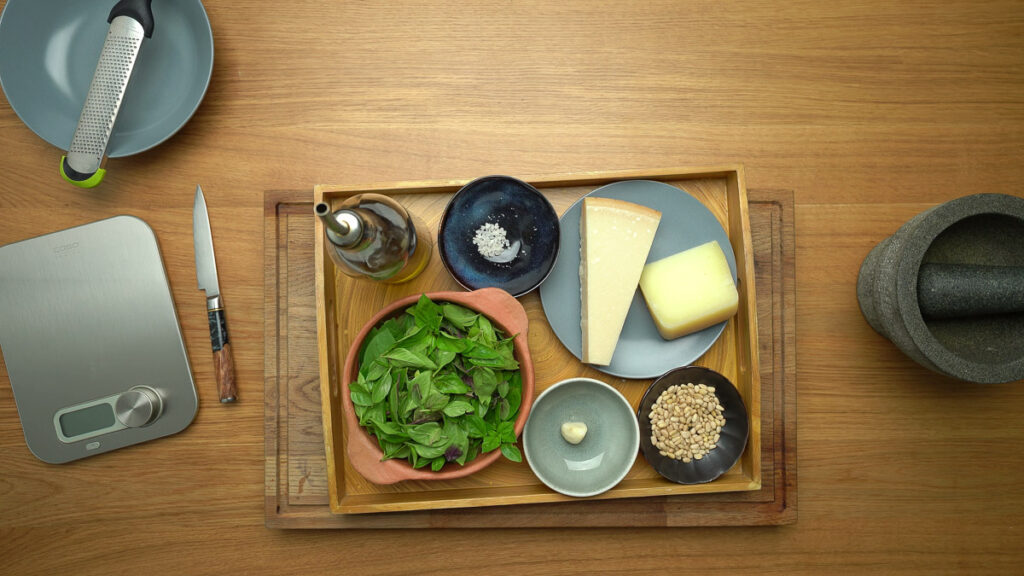
Now, let’s talk about what goes into making a truly authentic pesto alla Genovese Recipe. The key is using high-quality, fresh ingredients. You can find all the ingredients, including the quantities, in the recipe below.
Basil
First and foremost, you need fresh basil – ideally the Genovese variety. But don’t worry, you can just use the basil you’ll find, just be sure it is fresh, vibrant green, and aromatic.
Olive Oil
Next up is the olive oil. You wouldn’t skimp on the olive oil, would you? It’s crucial to use a high-quality extra virgin olive oil for that authentic taste.
Pine Nuts & Garlic
Pine nuts add a subtle nutty flavor, while garlic gives pesto its characteristic punch. I like to use just a half or a third of a garlic knob, as fresh garlic can easily overpower your whole Pesto.
Cheeses
As for cheese, a combination of Parmigiano-Reggiano and Pecorino Sardo/Romano is traditional. The blend of these two cheeses creates such a complex flavor profile! If you just have a good quality Parmesan cheese by hand, you can still end up with a very lovely Pesto!
Sea Salt
Finally, a pinch of coarse sea salt ties all the flavors together and will help you by grinding the fresh basil the classic way in a pestle and mortar. But be sure not to use too much as the cheeses are already quite salty.
How to make my authentic Pesto alla Genovese Recipe
Ready to make your own pesto alla genovese recipe? Let’s break it down step by step.
First, I suggest preparing all your ingredients. Make sure everything is fresh and ready to go – mise en place, as the French say!
A traditional Pesto alla Genovese Recipe is made using a pestle and mortar. It takes a bit more time and effort, but there’s something satisfying about making your own pesto by hand.
However, not everyone has the time or patience for the traditional method, though. Do you?” If not, on the contrary, a food processor works well too. Just be careful not to over-process – you want to maintain some texture.
The key is achieving the perfect consistency. “It should be creamy but not too smooth. You want to see little specks of basil, right?”
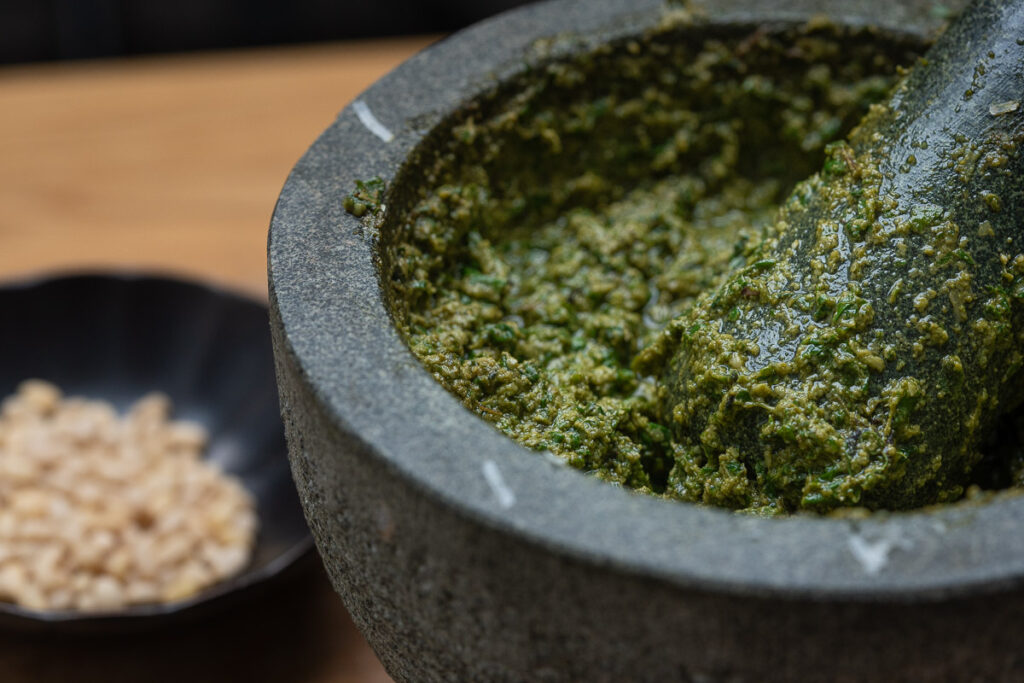
The Traditional Method: Pestle & Mortar
Below, I will describe step by step how you can make authentic pesto at home using the traditional method with pestle & mortar.
- First, grind the garlic into a smooth paste. Now add the pine nuts and also grind to an even, smooth texture.
- Now, step by step, add the fresh basil and grind into a smooth paste together with the sea salt. The salt will help to crush the basil leaves. Be aware that this process will take some time and effort.
- With the help of a microplane, finely grind the parmesan so as the pecorino cheese and step by step grind into the pesto.
- Finally, add the extra virgin olive oil and grind together. You can add as much olive oil until you achieve your desired consistency.
The Quicker Method: Food Processor
If you don’t have the time or additionally want to make Pesto in larger batches, you can easily make your homemade Pesto alla Genovese in a food processor. However, there are a few critical steps you need to be aware of to avoid oxidation and browning:
- As the blades of the food processor produce more heat, it is important to chill down your tools and especially the basil beforehand. Put the container of the food processor into the fridge or freezer before preparing the pesto. Also, cool down the basil leaves by putting some ice cubes on them or just putting the basil into the fridge for a while.
- Mix the ingredients in several short bursts, rather than running the blender continuously for a longer period.
- Put the garlic and pine nuts into the processor and grind into a smooth paste.
- Now add the basil, roughly pre-grinded Parmesan and Pecorino Cheese, Sea Salt, and some Olive Oil. Mix into a rough paste. Add the remaining olive oil until you get your desired consistency.
Watch how to make my Pesto alla Genovese Recipe
Tips for Perfecting Your Pesto
Let’s dive into some pro tips to elevate your pesto game.
When it comes to basil, selection and storage are crucial. Choose bright green leaves with no brown spots. And here’s a tip: store them like a bouquet in water at room temperature!
Have you ever tried toasting your pine nuts? It’s a game-changer. The toasty flavor adds depth to your pesto.
Garlic can be tricky. In fact, too much, and it overpowers everything. Too little, and where’s the kick?” Start with a small amount and adjust to your taste.
The same goes for salt and cheese. Taste as you go, and remember – you can always add more, but you can’t take it away!
Serving Suggestions and Pairings
Now for the fun part – enjoying your pesto!
“What’s your favorite pasta to serve with pesto?” Traditionally, it pairs beautifully with Orecchiette or linguine, but feel free to experiment.
But why stop at pasta?” Pesto is versatile – try it on sandwiches like my Italian Pesto Ham & Cheese Sandwich, as a topping on Italian Crostinis and Pizzas, or drizzling over roasted vegetables.. Yummy!
Lastly, if you have leftover pesto, there are a few tips below on how to store Pesto to prevent oxidation and keep the bright green color!
How should Pesto be stored?
There are a lot of questions and also a few mistakes you can make by storing your homemade Pesto. I’m covering the most common questions for you below, whether you want to keep your Pesto a few days in the fridge or freeze it in portions for longer.
How long to keep Basil Pesto?
You can keep Basil Pesto up to 7 days in the fridge when stored correctly. Put the Pesto in an airtight container and top the surface with a layer of olive oil or some plastic foil to prevent oxidation and browning.
How to keep Pesto from oxidizing?
You can keep Pesto from oxidizing by sealing it against air. Cover the homemade Pesto in an airtight container with a thin layer of olive oil or put some plastic foil directly on top of the pesto.
How can you tell if pesto has gone bad?
You can tell if Pesto has gone bad when it smells or tastes sour or chemical. When the first layer of the Pesto turned brown from oxidation, you can remove that layer; the rest might still be all right. However, when the taste is off or you see mold, throw it away.
Does pesto turn brown in the fridge?
Pesto can turn brown in the fridge when it is exposed to air. Be sure to cover the surface of the Pesto with some olive oil or directly put some plastic foil on top of the surface.
Can I freeze basil pesto?
You can freeze homemade Pesto by putting it into cube trays for several portions. Cover the surface with some olive oil. When frozen, transfer the Pesto cubes into a freezer bag.
Conclusion
There you have it – the secrets to creating an authentic, mouthwatering pesto alla genovese! With these tips and techniques, you’re well on your way to mastering this beloved Italian sauce.
Remember, the key is using the freshest and best ingredients you can get and letting their flavors shine. So, what are you waiting for? Grab your mortar and pestle (or food processor) and start creating your own little piece of Ligurian magic in your kitchen. Buon appetito!
Other Italian Recipes you might like
- 3 Flavorful Italian Crostini Recipe Ideas You’ll Adore
- Paccheri al Tonno, the Ultimate Italian Tuna Pasta Recipe
- Linguine Puttanesca
- Mortadella Pistachio Sandwich with Burrata
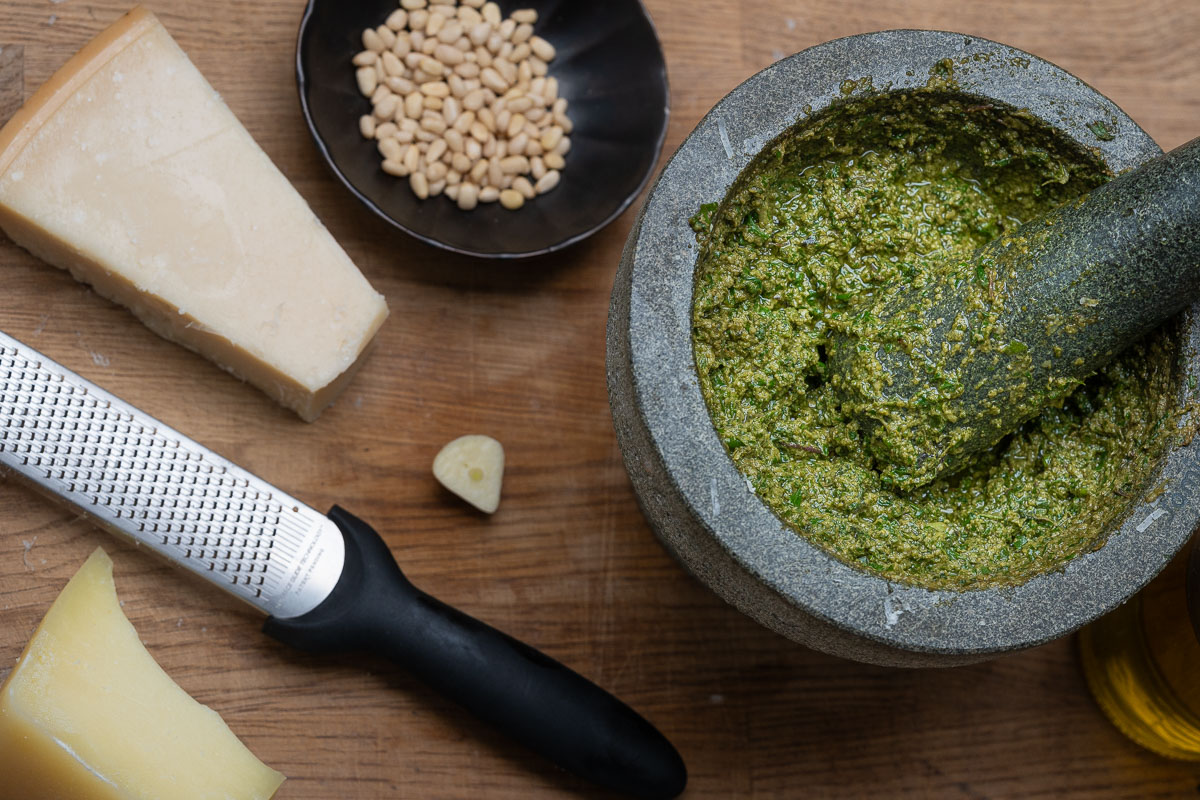
Authentic Pesto alla Genovese Recipe: A Taste of Liguria at Home
Equipment
- 1 big or medium pestle & mortar for classic production
- 1 Food Processor for easier and faster production (also ideal for larger badges)
Ingredients
- 60 grams Fresh Basil
- 70 grams Extra virgin Olive Oil
- 30 grams Parmesan Cheese Parmigiano Reggiano
- 15 grams Pecorino Cheese Pecorino Romano
- 20 grams Pine nuts
- 1 pinch coarse sea salt
- ⅓ knob Garlic
Instructions
Classic Method: Pestle & Mortar
- With the classic method, there is a lower chance of oxidation and therefore the pesto turning brown. Most of the times, the result will be a green and more "homemade-looking" pesto alla genovese. However, this method takes some time and effort to crush all ingredients into a smooth paste.
- First, crush the garlic in the mortar to a smooth paste. Now add the pine nuts and also crush to a paste.⅓ knob Garlic, 20 grams Pine nuts
- Add ⅓ of the basil and crush together with the coarse sea salt. From time to time, add the remaining basil and crush as long until you'll get a texture you like. The texture wont be as homogenous as when made in a food processor, but in my opinion That is what makes an authentic, handmade pesto so special.60 grams Fresh Basil, 1 pinch coarse sea salt
- Now grind the cheeses as fine as possible using a microplane, and then mix step by step into the pesto.30 grams Parmesan Cheese, 15 grams Pecorino Cheese
- You can now start to add the extra virgin olive oil step by step until you're happy with the consistency.70 grams Extra virgin Olive Oil
- You're done! Store your delicious homemade pesto alla genovese as described in the blog post above.
Easier Method: Food Processor
- This method is way easier and quicker but therefore there is a higher chance of oxidation and the pesto turning brown due to the heat that is produced by the food processor. However, there are a few tips to minimize oxidaton with this method which I will describe below.
- To prevent the pesto from turning brown due to heat or oxidation when preparing it in a food processor, it is important to use tools and ingredients that are cold as possible.Therefore, put the container of the food processor into the fridge or the freezer for a while before preparing the pesto. You can also cool down the basil leaves by putting them in a bowl and add a few ice cubes or just cool down the basil in the fridge.
- Put garlic and pine nuts into the food processor and grind to a smooth paste.20 grams Pine nuts, ⅓ knob Garlic
- Now add the cold basil, grated cheese, sea salt and some of the olive oil and rougly grind. Add the rest of the olive oil or the amount you need to get the consistency you like. Grind with several impulses until you get your desired texture.60 grams Fresh Basil, 70 grams Extra virgin Olive Oil, 30 grams Parmesan Cheese, 1 pinch coarse sea salt, 15 grams Pecorino Cheese

